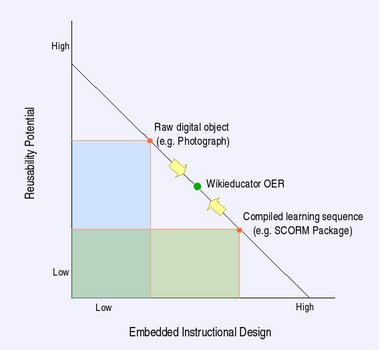Internationalising online programs/Internationalizing the Course Materials
Internationalising course materials - WikiEducator and the VUSSC
Description of activity
WikiEducator is a new collaborative OER project which aims to build free content courses and materials -- for all education sectors and levels --- that can be used and modified by educational institutions, wherever they are located around the world. Education is culturally bounded, consequently the internationalisation of course materials poses unique challenges for the reusability of OERs.
Consider for example, the Virtual University for Small States of the Commonwealth (VUSSC). Established by the Commonwealth Ministers of Education, this is an initiative involving 30 small nation states working collaboratively on the development content in WikiEducator to be used by tertiary education institutions covering diverse regions of the Commonwealth, namely: Africa and the Indian Ocean, Europe, the Caribbean and the Pacific Islands. A course in entrepreneurship designed for learners in Swaziland is likely to have very different needs from prospective entrepreneurs in Samoa.
WikiEducator's approach for the internationalisation of course materials is based on two foundational principles:
- The adoption of a free content license which permits member countries to modify, adapt and redistribute content resources; and
- Pioneering technologies which will facilitate the reuse of educational resources in a variety of contexts, particularly for learners that may not have access to the Internet.
The internationalisation of course materials is simultaneously a technological and pedagogical challenge, hence the need to distinguish between interoperability and reusability.
Distinguishing between interoperability and reusability
Interoperability is a technical challenge concerning how digital content developed in one environment or system can easily be transported or used in another system or environment. On the other hand, reusability is an education challenge, refering to how learning resources developed for a particular learning situation can be reused in another learning situation.
The reusability dilemma
Educators add value to learning content through the design of meaningful learning activities to facilitate the learner's understanding of different learning tasks. Moreover, a meaningful education experience requires quality interations among students and teachers which are difficult to encapsulate in standardised content. Reusability in education necessitates a well-found understanding of learner needs and different learning contexts.
With regards to digital resources, regrettably there is an inverse relationship between reusability and the educational design of teaching resources. Learning is always contextual, because the demands of the learning tasks may change and the characteristics of individual student groups are usually very different. Good teaching requires careful refinements and adaptations according to student needs in different learning situations.
Consider, for instance, a raw digital object such as a photograph. On its own, the photograph has little educational value until it is incorporated into an educational activity, and customised for use based on the student audience and the demands of the learning task. While a raw digital object does not have significant educational value, it can easily be reused in a variety of different contexts, for example the same X-Ray image can be used for teaching a first-year class of student nurses as well as a post-graduate course for inservice doctors. On the other hand, however, a compiled learning sequence adopting a problem-based learning approach comprising a range of activities exploring the relationships between supply and demand for a second year Economics class will have higher educational value, but is certainly not as reusable as the raw digital object example above. Consequently, the more educational design that is embedded in digital learning resources, the less reusable they become for different situations.
Educational content is characterised by a number of form elements that represent the design of a particular learning sequence, for example: articulating the intended learning outcomes, incorporating a number of interactions or activities for learners to engage with the learning task or opportunities for learners to assess their progress. WikiEducator refers to these form elements as instructional devices and have developed a series of pedagogical templates to assist with localisation of content for different countries. The hypothesis is that differentiating instructional devices from generic learning content will facilitate localisation for different contexts.
Benefits of the activity
- Creating opportunities for small nation states to participate in the internationalisation of education enabled by digital communication technologies
- Lowering the costs of producing asynchronous learning materials, especially for institutions with relatively low student enrolments
- Providing a voice for the developing world by transforming the model from consumers to co-collaborators.
- Pioneering new technological innovations that are appropriate for developing society contexts.
- Collaborating with industrialised nations as equal partners.
Success factors for the activity
- High level policy support as mandated by the Commonwealth Ministers of Education
- The facilitation role of an international intergovernmental agency (COL)
- Funding support from international donor agencies
- The need to expand access to educational opportunities
- An enabling environment facilitated by the use of social software technologies.
Organisational readiness factors
- Educational institutions need to dedicated staff time to the development of course materials. Ministerial commitment does not necessarily translate into educational administrators allocating staff time to the project.
- A willingness to experiment with emerging technologies
- A pioneering disposition to generate the future rather than replicate the past.
Exit and sustainability plans
- Sustainability will depend on tangible examples of success, namely real students taking real courses developed using free content resources developed collaboratively.
- Investments in developing free content resources will not be lost, given the adoption of a free content license.
- Donor funding is a prerequisite as "venture capital" to establish the foundations for a sustainable business model.
- VUSSC is a long term strategy and premature exit will compromise the project.
- The collaborative development of a transnational qualifications framework is a critical success factor for this project.
